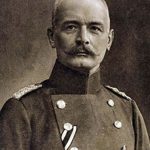Hiroshima had a population of roughly 300,000 in 1945. It was a military base, port, and popular seaside resort in the western part of Honshu Island, Japan. The Potsdam Declaration on 26 July was the last of the conferences attended by the leaders of Russia, The United States, and Great Britain – those countries whose empires were considered to have been the victors at the end of the Second World War. Previous conferences, at Yalta and Casablanca had been attended by Winston Churchill (Britain) and Roosevelt (USA), but the latter was dead, and Churchill had been defeated in a General Election.
His replacement as Prime Minister had been his deputy PM throughout the War, Clement Attlee, a liberally-inclined Socialist and leader of the British Labour Party. Russia was represented at Potsdam by the cleverest and most malevolent of the orginal Three – Josep Stalin. America’s new President was Harry S. Truman.
Potsdam called on Japan to surrender unconditionally. The Emperor, Hirohito could not or would not countenance the idea of surrender under any guise, because of his honour. President Harry Truman and his advisers decided to use a weapon developed from its German beginnings by American scientists – the Atomic Bomb. This would persuade Japan to stop fighting. Everybody except the Japanese was tired of the War, which had already lasted six intolerable years.
Though the scientists responsible for developing this awesome weapon had advised against using it, for the sake of the future of Humanity, America’s leaders dropped it without warning on a military target in a thickly populated area – Hiroshima.
It was August 6, 1945 when a B29 bomber released its atmoic bomb from a height of 32,000 feet. It was timed to drop for forty-five seconds before exploding. In fact it was nearly two thousand feet above the city of Hiroshima when it went off.
Many people were killed immediately by the explosion itself. The heat was intense, so much so that only the outlines of humans were etched on paving and walls. Then came the blast generated by the explosion, the force of a 500 mph wind generating temperatures of approximately 6000º C.
A rough circle of two miles diameter was now rubble and flattened buildings adorned with body parts. Some of the population had survived the explosion but died soon of the effects of radiation. It is possible that 100,000 or more people were killed by one single bomb. It did not have the required effect on the government of warlike Japan or Hirohito, so the ‘Allies’ dropped a second bomb, on the port and resort of Nagasaki and Japan surrendered on 4 August.
Ever since those two memorable days, argument has been waged fiercely and emotionally about the rightness or wrongness of dropping an atomic bomb on the first day, and even more so over the thorny question of why the second bomb was dropped at all. Harry Truman always held the opinion (until his death) that the use of nuclear power was a military necessity: the Japanese had resisted the ‘Allies’ fanatically on islands such as Okinawa, and Truman’s team thought that hundreds of thousands of American troops would be sacrificed if war at its normal level had continued in an already outlined invasion of Japan. It is however a historical fact that many of Truman’s generals had said that nuclear force was unnecessary: General Eisenhower, who had masterminded the invasion of France from Normandy, said later that he had advised Truman not to use the bomb. But he said this before he became President himself, so the statement may have been a vote-catcher.
Harry Truman’s Chief of Staff always asserted that the Japanese were indeed ready to surrender and that the use of ‘barbarous weapons’ was of ‘no material assistance’. One popular view among historians is that the two bombs were used to teach a hard lesson to Russia, which was already spreading Soviet influence in the Far East. Secretary of State Byrnes said that dropping the bombs would make Russia more ’manageable’ in the future.
To the extent that the Cold War that followed the hot one actually prevented war because both Soviet Russia and the United States possessed nuclear weapons, leading to stalemate in bellicose relations, Truman was perhaps right in destroying Hiroshima and Nagasaki – but Truman was not thinking about a future balance of terror. He was trying to stop interminable war with the Japanese.
Harry Truman was an unelected President: he had taken the post because of the untimely death of President Roosevelt, with whom he had been Vice-President. It is perfectly possible that he feared and hated Soviet Russia more than Japan, a country about which he knew little. He ended Lend-Lease in 1945, which did not improve his relations with Britain and France. His ‘Truman Doctrine’ was adopted in response to a perceived threat of Soviet expansion during the period of the Cold War. He was actually elected President in 1948, mainly on the promises outlined in his ‘Fair Deal’ programme.











Leave A Comment